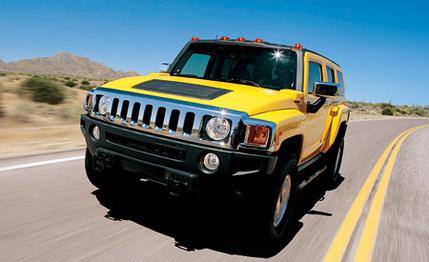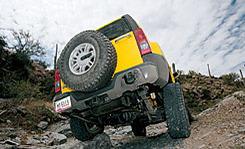 Road Test
Road Test
If less is more, as was famously asserted by a certain Mr. van der Rohe, then this new Hummer H3 is a lot more than GM's original whopper H2 because there's a lot less of it. That means you can pee-oh Sierra Clubbers with what looks like a full-Philistine SUV, yet you can get onto the road for the low, low base price of $29,500. The H3 is an easy costume to wear every day. It rides well, turns in tight 37-foot circles, and on the highway scores up to 20 mpg with the manual transmission, according to the EPA. Offending every greenie in town has never been so easy.
For many, that's the whole point of a Hummer--flaunting its assault-vehicle styling. But there's a special capability beneath the swagger. When the going gets tough, Hummers get going. For fording streams, climbing over treacherous rocks, and bulling through the brush, Hummers saunter in where few large vehicles dare. And this new H3 is arguably better than the original civilian whopper because it's less bulky: 16.8 inches shorter overall, 6.5 inches narrower. You can see out of it better, too.
This is a new truck, but hardly "all-new." (What from GM ever is?) The H3 is based on the Chevy Colorado/GMC Canyon small-pickup chassis and drivetrain, with significant changes down in the muscle and bones to endow it with Hummer capability. The torsion-bar front suspension is pushed forward 2.3 inches and downward by 1.2. That shortens the front overhang and pushes the frame up for more clearance below. The front control arms are also strengthened and lengthened about 1.5 inches on each side to widen the track. So the tires are out to the H3's shoulders for good stability on side slopes. They are also well outboard of the frame, which allows them to steer tighter angles.
A good off-roader is built on two basic ideas: Don't get the bottom hung up on terrain, and don't lose traction. On that first requirement, the H3's approach and departure angles are somewhat less heroic than those of the H2, and its 9.1-inch ground clearance is 0.9 less, but few SUVs can match them nonetheless. In the traction department, all H3s have full-time all-wheel drive with a locking center differential and an electrically controlled low range. The Adventure package ($1025) includes upsized 33-inch tires (285/75R-16 Bridgestone Dueler A/Ts on the test truck), various underbody armor plates, and a locking rear differential.
Adventurers also get a super-low reduction ratio in the transfer case, 4.03:1 instead of 2.64:1. How low is it? First gear oozes along at 1.7 mph per 1000 engine rpm compared with 2.5 to 2.9 for the typical soccer-mom SUVs--if they even have a low range. This "granny gear" provides slo-mo crawling over rocks with superb control. Serious off-roaders prefer a manual gearbox, if a granny gear is part of the package. The softly connected driveline of a torque-converter automatic requires exaggerated throttle openings to climb an obstacle and then gives zilch engine braking down the other side. With a manual and low-ratio transfer case, the vehicle crawls as if it were cogged directly to the earth's surface at a pace precisely controlled by your foot.
Unlike the H2, which has many plastic body parts, the H3 is mostly steel, even the hood. Plastic forms the overfenders, the bumper covers, and the "airbox features" (you know, those rectangular lumps just forward of the A-pillars). Whereas the H2 fakes its airboxes with upside-down plastic cake pans, the H3 vents the engine compartment through them.
 To Hummer stylists, this airbox gesture is a critical component of "Hummerness," along with the absurdly vertical windshield, round headlights in square holes, seven-slot grille, simulated tire-pressure inflators on the wheels, and spare hanging off the back.
To Hummer stylists, this airbox gesture is a critical component of "Hummerness," along with the absurdly vertical windshield, round headlights in square holes, seven-slot grille, simulated tire-pressure inflators on the wheels, and spare hanging off the back.
The H3 convincingly struts the full Hummerness costume on the outside, but it could pass for a nicely trimmed SUV inside, a welcome relief from the in-your-face festival of insincerity on display in the H2. The H3's thick-rim leather wheel and shift handle feel right to hands, the dash vents blend into the background as if camouflaged, and there's not a socket-head fastener in sight. The pewter-hued surrounds of the cluster and center stack have a quality look about them, and the dial markings are legible and unselfconscious.